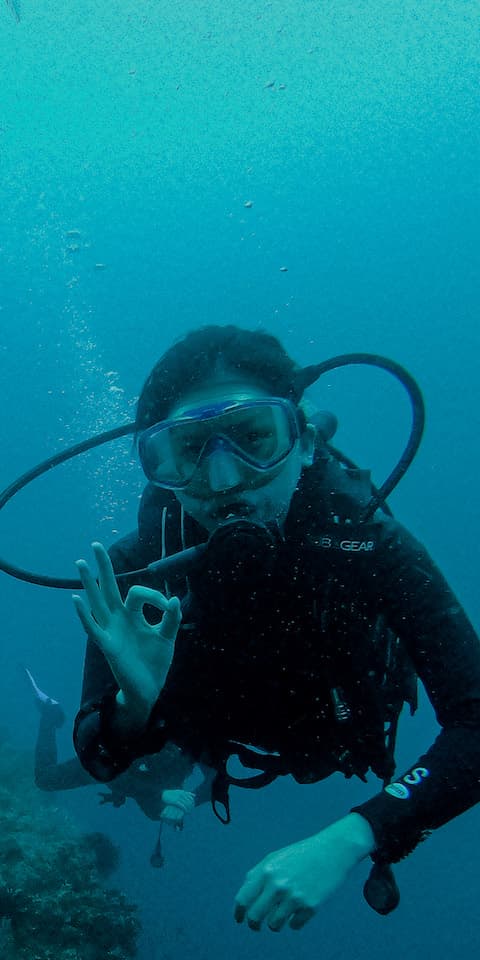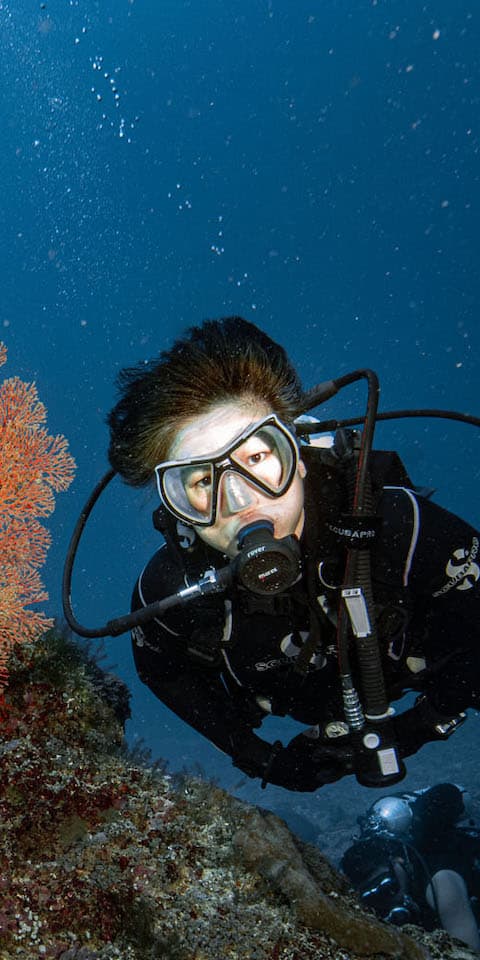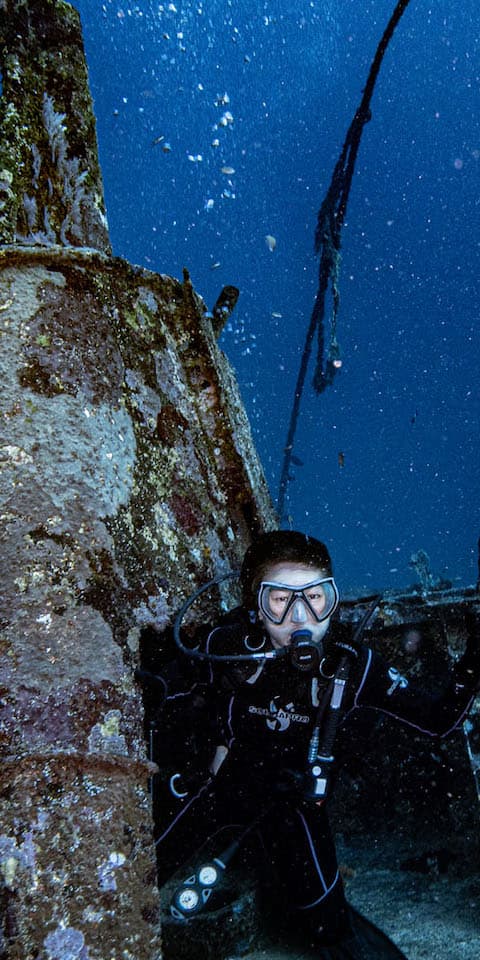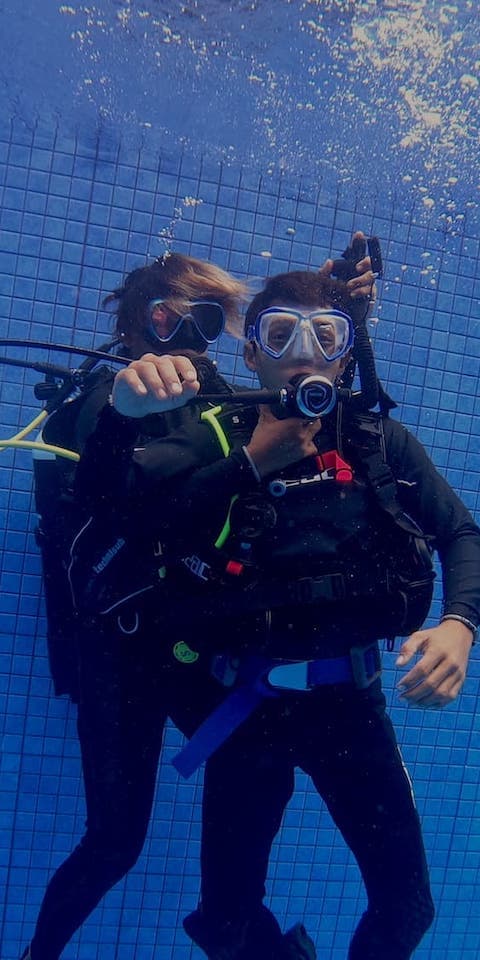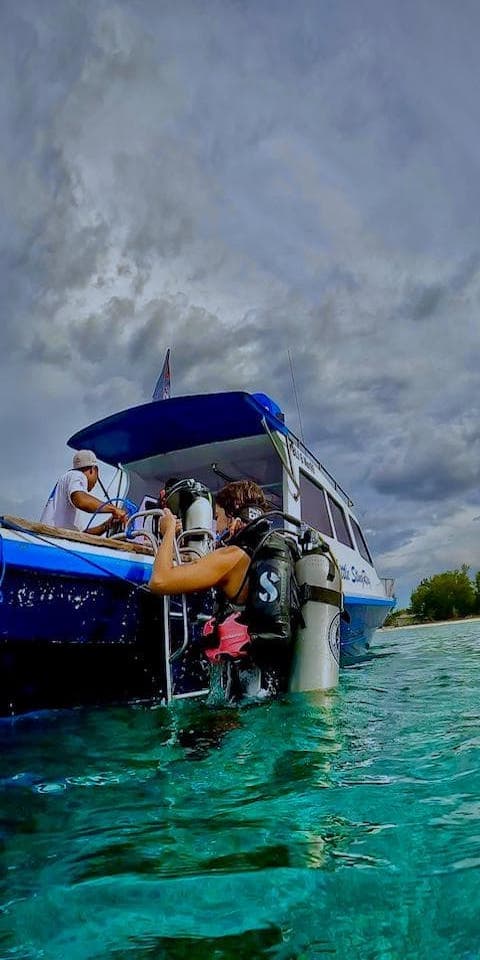PADI Advanced Open Water Divers, The next step is Open Water certification
Welcome! As a certified Open Water diver, You have discovered that diving is an adventure-the doorway to an amazing world of unique sights, sounds, and sensations. But that’s actually not enough, there’s still a lot of adventure and experience, and that’s what you’ll learn in the PADI Advanced Open Water Diver course.
Padi Advanced Open Water (AOW) Divers is a continuation of the open water diver course. You learn how to think more like an experienced diver, which builds your abilities, skills, and confidence. This course is more about skill learning and a few knowledge review questions to answer. With Padi e-Learning you can learn theory or knowledge development, this means we need to understand a little about advanced diving theory, so we can do scuba diving safely. You can do this through the Padi e-Learning platform. This means you can download programs from PADI and do all the theory and learning from home.
Why should you take the Advanced Open Water License?
If you like a challenge and want to get more experience such as: diving deeper, practicing buoyancy performance, and want to do night dives, with a view this is the time for you to get your license Advanced Open Water Diver Course. Because took the license you will get all these skills here, and you will be more confident diving with your buddy. This course is about improving your diving skills such as:
- Altitude Diving
- Boat Diving
- Deep Diving
- Digital Underwater Imaging
- Drift Diving
- Fish Identification
- Night Diving
- Peak Performance Buoyancy
- Underwater Navigation
- Wreck
Diving Of the skills above you must complete diving skills, namely: Deep Diving, Underwater Navigation, and 3 other diving skills according to your interests. Some popular options are: wreck diving, drift diving, and night diving. The instructor will discuss all available options with you.
Prerequisites
- You must have Open Water Diver certification (PADI, SSI/NAUI or other equivalent)
- Minimum age 12-15 years for PADI Junior Advanced Open Water Divers
- Minimum age of 16 years for PADI OWD certification
- Can swim 200 meters
- Medical clearance for pre-existing conditions
- There are several rules when flying to a high altitude after a dive. You must wait for a minimum of 12 to 18 hours after your last dive before your flight
This Course Includes
- All equipment is free
- PADI e-learning course
- PADI e-certificates
- Logbook
Frequently asked questions
PADI Advanced Open Water Course is a diving course for two days and can be completed full-time or part-time according to the adventure dive you choose. The instructor carries out the preparation and execution of the dive plan with you. All dives are done in the ocean!
- Day 1: Course introduction, theory review, and three dives
- Day 2: Knowledge development and two dives
Day 1
The instructor will review a little theory that you have learned in PADI e-Learning. You will do 3 dives under the supervision of an instructor, where each dive must complete the skill.
→ Dive 1
The trip to the dive site using a boat. While on the boat, the instructor gives a briefing about the diving spots that will be visited and what needs to be paid attention to when diving. You will dive from a depth of 18 meters down slowly to a maximum depth of 30 meters. This is a Deep Dive skill that you must do and always be supervised by your instructor.
With respect to recreational diving, “Deep Dive” is diving deeper than 18 meters / 60 feet with a maximum depth limit of 40 meters / 130 feet. For some, this is an interesting challenge. Although 40 meters / 130 feet is the maximum depth for recreational diving, ideally 30 meters/ 100 feet is the recommended limit for advanced open water divers and, in any case considered the optimum recreational depth limit. The deeper you dive, the more oxygenated air you consume. The importance of good buoyancy control and breath control is good so that the air you consume doesn’t run out quickly. Some big fish that you can find at a depth of 30 meters.
→ Dive 2
After completing dive 1 you need to rest for 30 minutes before continuing with dive 2. After the break, the instructor will give you a theory on how to use a compass, this is a skill in Underwater Navigation. If you feel disoriented while diving, you know it can create anxiety, especially when your air consumption is low, and you’re not sure where to go. The Underwater Navigation skills you learn can take stress and confusion away because you will always know where to be, where to go, and how to get to the boat or beach.
Navigation helps you plan more effectively, by managing the time and air consumption required to reach your destination and return. For example, if you and your friends are planning to take pictures at a predetermined spot, you can swim straight there instead of wasting time looking for it. You can spend more time doing what you’re doing and less time trying to find your way.
→ Dives 3
This is the 3rd and last dive on your first day of diving. This is a skill you learn that is Night Diving. Why dive after dark?
before if you are learning to dive for the first time, Night Diving may sound intimidating – who wants to go underwater at night? However, having experienced day diving, most divers feel drawn to diving after dark. What are your hopes for doing a night dive, including:
- Curiosity – Many divers want to see what diving is like at night, which is what you’d expect from people as adventurous as divers
- Nocturnal life – You see organisms at night that you don’t see during the day, and witness different behavior of some creatures compared to what you see during the day
- A new look at familiar sites – Visiting a favorite spot at night is a great way to see it fresh, as if diving there for the first time
- “True” colors – Colors appear more vivid at night because they are lit by your dive light, instead of the natural light that has been filtered by the water. Plus, everything is wrapped in night black, creating contrast.
Day 2
The instructor will provide a bit of knowledge development and planning dives with you. This is the last day you complete the skill with the option you selected. You will do 2 dives under the supervision of an instructor, and each dive must complete the skill. If you have completed all the skills you have to do, at the end of the dive, you will be declared a certified advanced open-water diver.
→ Dive 1
As usual, the trip to the dive site using a boat. While on the boat, the instructor gives a brief briefing about the diving spots that will be visited and what needs to be considered when diving. Drift diving is the next diving skill that you do. Drift diving is diving with the current, not against it. This is any form of diving in light to heavy currents where your exit point is significantly on the way down your entry. Controlling buoyancy is very important so that when doing drift diving you don’t damage the corals and regulate your breath so that air consumption doesn’t run out quickly.
→ Dive 2
After completing dive 1 you need to rest for 30 minutes before continuing with dive 2. After resting, the instructor will plan the dive to the next dive site. On this dive, you will learn the skill of Wreck Diving.
It doesn’t matter where you dive salt or fresh water, temperate or tropical, inland or offshore – there’s something about shipwreck diving that gets most divers excited. Whether a large ship that is almost intact or the remains of a ski boat, whichever wreck makes a diver’s attraction. There are four common reasons divers love Wreck Diving namely:
- Curiousity – There is something interesting about shipwrecks. You start asking yourself about their story. What caused this wreck to sink? What will we find?
- History – The historical nature of many shipwrecks is also important because some wrecks are fragile, and divers play a role in helping to preserve and protect them
- Aquatic life – Shipwrecks become artificial reefs that attract aquatic life. In some areas, you will find only concentrations of aquatic life in and around the wrecks, and some divers are most interested in what lived on the wrecks
- Imaging – Shipwrecks make dramatic backdrops for videos and up to the imagery of divers and wildlife. Many shipwrecks are photogenic in themselves, making them popular subjects for landscape shots, or locations for photos and videos of divers.
- Learn new skills and knowledge
- See marine life in its natural environment
- Get out of your comfort zone
- Be a more independent diver
- Make new friends from all over the world
Trawangan Stingray Divers provides complete assistance to those who wish to enjoy worry-free diving. You are not only provided with useful information but also escorted to make sure everything is running safely. Following are some of the advantages of entrusting your diving experience with Trawangan Stingray Divers:
- Complete information about the best spots, terrain conditions, and tips when taking courses
- Adequate diving equipment
- Professional supervision
- Help during diving
- Licensing course to be able to do diving
- Competitive fees
- Enjoy hassle-free diving
- Safety is guaranteed during diving
Entrusting diving activities to experts is a wise and safe choice to avoid various risks. So please join us to get the best to guide you.
PADI Advanced Open Water
Plan & Pricing
4+1 (4 divers + 1 instructor)
5,400,000
per personFeatures:
- 2 days
- Practical and theoretical, communication, skills, dive planning, use of a dive computer
- 5 dives in the sea
- All equipment
- Instructor
- Price included: snack/biscuit, lunch, coffee or tea, mineral water, towel, boat and full-set dive equipments
